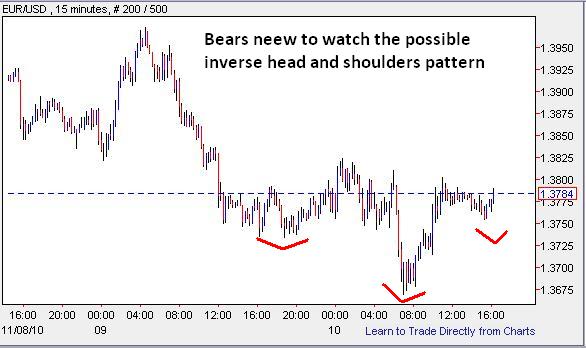
Looking at the bigger picture wave count in stocks we might be in for a flat few months ahead as a Minute wave ((iv)) takes hold. There was a pretty big and sharp move for Minute wave ((ii)) and elliott wave principle's guideline for alternation suggests we'll see a more flat correction for wave ((iv)). This means we'll most likely have a triangle or "flat" correction take us into 2011. My best guess at this point is a sideways move in stocks into the first or second week of January 2011 where buying interest is usually strong which might give us Minute wave ((v)) and finish off Primary wave ((2)) once and for all. I would love to see a triangle form at this point because it would be a clear sign of a topping formation occurring, and the ensuing sharp thrust and reversal will in fact finish off the previous trend.
It's still important to note that the XLF's lagging behavior, silver's apparent blow-off top, and the US dollar perhaps having put in a major bottom, we must be vigilant in watching for stocks to top Primary wave ((2)) at any time. I'll be focusing a lot on the euro and the XLF in the coming weeks because I feel those two markets can give us the best clues as to whether or not Primary wave ((2))'s top is near or not. Also note that tech giant Cisco is down almost 16% at the time of writing, and they are often a leading indicator of where the overall market is heading for the next quarter. I'm not saying the market will drop 16% as well, but the overwhelming weakness is Cisco seen today may be a sign of weakness ahead for the stock market. Also note that today is the Veteran's Day holiday so perhaps not all market participants are fully engaged in trading and may not return until Friday or Monday. So the selling we see in the overall market right now may not even be near complete.
Speaking of the euro, I'm posting the daily chart here of the euro vs the US dollar. It shows a clear 5 wave decline I'm labeling an Intermediate wave (1), followed by a Minor ABC correction for Intermediate wave (2). The triangle, thrust and reversal for Minute wave ((iv)) and ((v)) was our first clue of a major top being at hand. If the above count is correct, the euro should be well on its way to parity with the US dollar, and probably much further. A euro decline of this magnitude would mean a major rally in the US dollar would put significant pressure on commodities and stocks in the process. So even if you don't trade currencies, it's worth at least tracking the euro and the dollar for clues to the future movement of commodities and stocks.
PLEASE NOTE: THIS IS JUST AN ANALYSIS BLOG AND IN NO WAY GUARANTEES OR IMPLIES ANY PROFIT OR GAIN. THE DATA HERE IS MERELY AN EXPRESSED OPINION. TRADE AT YOUR OWN RISK.









